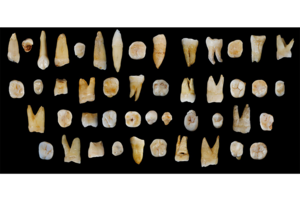Can 100,000-year-old teeth change human history?
Archaeologists unearth human teeth in China from 50,000 years before humans were thought to live there, in 'one of the most important finds coming out of Asia in the last decade.'

47 human teeth found in the Fuyan Cave, Daoxian.
Courtesy of S. Xing and X-J. Wu
Archaeologists found 47 teeth in a cave in southern China that could put a fresh perspective on ancient humans.
These teeth belong to Homo sapiens, that is, anatomically modern humans – ones who, according to current archaeological theories, didn't exist in Asia at that time.
Dated between 80,000 and 120,000 years old, these teeth place Homo sapiens in Asia tens of thousands of years earlier than previous research, dramatically rewriting the story of how modern humans spread out of Africa, say researchers.
Modern humans supposedly arrived in Asia 50,000 years ago, according to the dominant "Out of Africa" hypothesis that describes the migration of modern humans out of the region where they are thought to have evolved.
But these teeth change that timeline, according to a study published Wednesday in the journal Nature.
"They are from 30,000 to 70,000 years earlier in China than it was generally accepted that our species would have reached this region," wrote study co-author María Martinón-Torres in an email to The Christian Science Monitor.
"This is stunning. It’s major league," said Michael Petraglia, an Oxford archaeologist not involved in the research, to Nature. "It’s one of the most important finds coming out of Asia in the last decade."
A dental match
These ancients are certainly our ancestors, the scientists say.
"In terms of dental anatomy they are indistinguishable from us," says Dr. Martinón-Torres.
The 47 teeth are the only human remains found in the southern China cave, as teeth, with their hard enamel coating, often survive much longer than any other kind of bone. And fortunately, teeth offer many forensic clues.
"Teeth can provide a lot of information about the species we belonged to because their size and morphology are highly inheritable," Martinón-Torres says. "They can also provide information about diet, about pathologies suffered from these groups and about culture, as depending on what you use the teeth for you can live some specific patterns of wear."
How did modern humans out-compete the muscular Neanderthals?
Scientists have long discussed what could have caused the extinction of our Neanderthal cousins, Homo neanderthalensis, the ancient human that lived in Europe before H. sapiens moved in.
This new understanding of modern human migration out of Africa could paint a clearer picture of the stronger, older species's demise, says Martinón-Torres.
"For a long time, it was thought that the entry of H. sapiens into Europe triggered Neanderthal’s extinction," she explains, but knowing H. sapiens trekked thousands of miles from Africa long before they appeared in Europe suggests a more long-standing tension.
"Neanderthals may have been a barrier for the entrance of H. sapiens," she says. "It may have not been easy for them to take over the land that H. neanderthalensis were occupying for hundreds of thousands of years."
Instead of H. sapiens pushing out the brawny Neanderthals as soon as they migrated out of Africa, it likely took generations to supplant them.
A barrage of difficult climatic conditions could have weakened the Neanderthals over hundreds of thousands of years, giving H. sapiens an opportunity to move into the region and push the earlier humans to extinction.
The archaeological site
These history-changing teeth were unearthed in Fuyan Cave, a limestone cave in Daoxian. The southern China site also yielded remains of hyenas, extinct giant pandas, and other animals, but few clues to life in the region 100,000 years ago.
"We do not know much," says Martinón-Torres. "Unfortunately, there are not stone tools at the site and because of taphonomic (conservation) problems, only the hardest parts of our body (teeth) in both the case of the humans and the animals survived to our days."
Based on the limited evidence of human activity, she says, humans probably did not live in the cave.
More questions to answer
Researchers still don’t know how the humans migrated to Asia from Africa or what happened next. Martinón-Torres says she and her colleagues will compare the Daoxian specimens, other Late Pleistocene human fossils, and modern humans to better tell the story. Genetic information and other archaeological data will help them map the route between the continents and shed more light on these early travelers.
"Asia has an important role in the study about the evolution of our own species, H. sapiens, which has been classically attributed solely to Africa," says Martinón-Torres.


